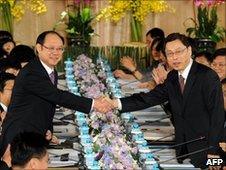Taiwan and China agree details of key trade deal
- Published

The two sides have been negotiating the deal for months
Taiwan and China have finalised details of what many believe will be the most important agreement between the two sides in 60 years.
The agreement - similar to a free-trade pact - will cut export tariffs and give more access to each other's market.
While it is expected to boost Taiwan's $390bn (£260bn) economy, critics are worried it could give China too much influence over the democratic island.
The two sides split at the end of the Chinese civil war in 1949.
Cheaper goods
Following a year of negotiations, the two sides hammered out the agreement on Thursday. It gives Taiwan more economic benefits than China.
More than 500 Taiwanese products - including auto parts, petrochemicals and fruit - will be able to enter the booming Chinese market with reduced tariffs immediately and no tariffs within three years.
Only about half the number of Chinese products will get similar treatment in Taiwan.
Taiwan's government said the deal will boost trade, increase economic growth and help the island's exports stay competitive.
But critics fear it could unleash a flood of cheaper Chinese goods, cost thousands of jobs and make Taiwan too dependent on China.
And they warn it could be the first step by Beijing to eventually take back Taiwan, citing the unusual concessions Beijing has made.
China still considers Taiwan its province and has more than 1,000 missiles targeting the island to warn it against declaring formal independence.
The agreement is scheduled to be signed in China next Tuesday.
A major demonstration is being planned in Taiwan by the opposition party Saturday to protest against the agreement.